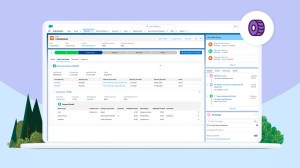Jo-ann Olsovsky is Executive Vice President and CIO at Salesforce. In her role, Jo-ann leads the team responsible for all of the internal technologies and operations that empower Salesforce’s 50,000 employees worldwide to succeed in their daily roles. With so many employees working remotely worldwide due to the pandemic, Jo-ann and her team have focused heavily on implementing Salesforce automation technologies throughout the organization to increase overall work efficiency and streamline time-consuming processes.
In this interview, we asked Jo-ann about her experience in implementing automation within Salesforce, how it helps increase the speed of work, and how she sees automation benefiting organizations in 2020 and beyond.
Q. Why did Salesforce implement automation solutions internally, and what challenges are they solving?
The main driver behind implementing automation across the organization is that we truly value our employees and want them to be equipped with the tools they need to work smarter and more efficiently. Asking employees to complete mundane, time-consuming tasks in their day-to-day work just isn’t a good experience, or the best use of their time.
The biggest benefit automation offers is the ability for employees to increase productivity and scale their workloads. Automating processes in the background allows employees to take on more meaningful projects without feeling overwhelmed, and gives them the necessary downtime to do things like think creatively, solve complex problems or plan ahead. Computers and automation are a great solve for completing routine tasks so our people can be focused on more thought-provoking challenges.
Q. Salesforce is a large company with many internal departments that can benefit from automation. How do you decide and prioritize which internal processes to automate?
The first step we took when we were working to implement automation was to align with all of our business partners to understand their biggest challenges – what time-consuming tasks existed and what would help them to offload. Once we understood the challenges that could be handled by automation, we then focused our resources on the processes that were most time-consuming and repetitive – eliminating these first provided the most return for both the employees and the business. I had a former leader that used to tell me, “If you want to know how efficient your organization is, look at how it’s people spend their time.”
For example, we partnered with our Finance and Employee Success teams to implement Robotic Process Automation (RPA) to improve business controls, reduce manual data entry errors, and save employees time. Not only did automation help remove the mundane task of manual data entry from employee’s to-do lists, but it also provided clear business value by providing us with data that is more accurate and less prone to errors.
Q. What is a recent challenge Salesforce faced that automation helped solve?
One of the biggest challenges we faced recently due to the pandemic was hiring and onboarding. Despite the pandemic, Salesforce has continued to hire thousands of people around the world, which poses a challenge when it comes to getting new hires company devices, like laptops and phones, as well as getting them access to all of the right systems and resources to efficiently onboard them into their new roles. By automating some of the repetitive administrative tasks that come with every new hire — such as communicating to new employees what internal resources are available to them and what onboarding tasks need to be completed — our IT teams were able to efficiently provision new employees with the equipment they needed while HR teams were able to easily onboard them. Automation plays a huge role in allowing our HR teams to focus on the more personal touches that make our new team members feel like a full part of our Ohana, which is even more vital in this new work-from-anywhere world. Best of all, our new employees rave about the onboarding experience.
Q. What would you say is one of the biggest misconceptions when it comes to automation?
One that I generally hear is that advancements in technology will limit job opportunities. If we use history as our guide, technology advancements generally give rise to entirely new industries that didn’t previously exist. Take the smartphone, for example. Prior to smartphones consumers often had to handle transactions physically, whether that was buying a movie ticket or depositing a check. Today, smartphones are ingrained in our lives, and while the number of physical transactions has gone down (thus impacting that industry) there’s now an entire app-based economy that employs thousands of people to build applications that allow us to complete those transactions on a mobile device. The workforce hasn’t gone away — it’s just shifted focus.
In the context of automation, I believe we will see the same thing. As time progresses and automation continues to manage a larger share of our mundane work tasks, organizations will look to shift their workforce to handle more of the “human” side of jobs — tasks that require critical thinking, or empathy.
If we use history as our guide, technology advancements generally give rise to entirely new industries that didn’t previously exist.”
Jo-ann Olsovsky
Q. How do you see Salesforce leveraging automation in the future?
We’ve already seen great results from automating our internal processes and I’m excited to continue scaling those implementations in 2021 and beyond. I’m also equally as excited that we are sharing our tried-and-tested automation products with our customers through recent product launches like Einstein Automate. With Einstein Automate, our customers will benefit from the same workflow and process automations that Salesforce uses to save time, increase productivity, and ultimately provide better experiences for both employees and customers.













